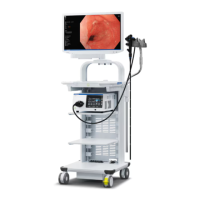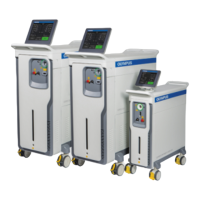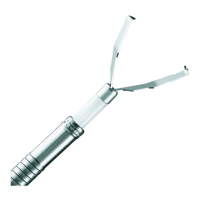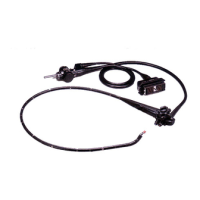70
Chapter 4 Operation
ULTRASOUND GASTROVIDEOSCOPE GF-UCT180
Insertion of EndoTherapy accessories into the endoscope
• Do not insert EndoTherapy accessories forcibly or abruptly.
Otherwise, the EndoTherapy accessory may extend from the
distal end of the endoscope abruptly, which could cause
patient injury, bleeding, and/or perforation.
• When the biopsy valve’s cap is detached from the main body,
it is easier to insert an EndoTherapy accessory into the
instrument channel port (see Figure 3.10 on page 37).
However, the open biopsy valve, after withdrawing an
EndoTherapy accessory, can reduce the efficacy of the
endoscope’s suction system, and it may leak or spray patient
debris or fluids, posing an infection control risk. When not
using an EndoTherapy accessory, attach the cap to the main
body of the biopsy valve.
• When the biopsy valve’s cap is detached from the main body,
it may cause patient debris or fluids to leak or spray from the
endoscope, posing an infection control risk. When the biopsy
valve’s cap has to be detached, place a piece of sterile gauze
over it to prevent leakage.
• Do not let the EndoTherapy accessory hang down from the
biopsy valve. Doing so can create a space between the
accessory and the valve’s slit or hole. This can cause
damage to the valve that can reduce the efficacy of the
endoscope’s suction system, and may leak or spray patient
debris or fluids, posing an infection control risk.
• When inserting an EndoTherapy accessory, hold it close to
the biopsy valve and insert it slowly and straight into the
biopsy valve. Otherwise, the EndoTherapy accessory and/or
biopsy valve could be damaged. This can reduce the efficacy
of the endoscope’s suction system, and may leak or spray
patient debris or fluids, posing an infection control risk.
When using the aspiration needle (NA series), refer to the
instruction manuals for the aspiration needle (NA series).
Otherwise, the instrument channel and/or the EndoTherapy
accessory may become damaged.

